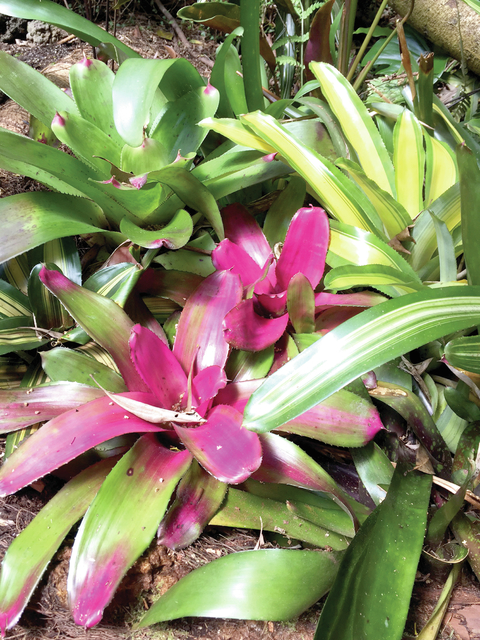Tropical Gardening: Cool season means change for Hawaiian gardens

As the weather cools down a bit, folks start thinking about garden projects.
ADVERTISING
From 8 a.m.-1 p.m. Saturday, Oct. 29, at the Old Kona Airport State Recreation Area, island residents will get an opportunity to check out some interesting new plants, including bamboos. Nursery folks will be there to answer your questions about what to plant and the care in your special climate zone.
In West Hawaii, the fall weather brings on the dry season. In fact, from October-April, we have almost no rain. This fall appears to be another dry start, so keep in mind the importance of sufficient irrigation to keep gardens in top shape.
East Hawaii, on the other hand, has been drenched as it goes into the rainy season, so garden projects will vary depending on your local climate.
Many annuals can be used to give gardens fall color. A list of the popular garden annuals of today reads like a page from the past. Garden shops are carrying coleus, impatiens and geraniums, but when you start talking varieties, they are as modern as today.
New coleus plants, for instance, are a far cry from the tall, spindly, dull coleus most of us remember. Plant breeders developed varieties with improved form and a wide range of color combinations that add color and texture to shady areas.
Grandma’s begonias, too, left something to be desired. Today, thanks to intensive breeding efforts, fibrous-rooted begonias have come out of hiding. Originally a shade-loving plant, they can now also be grown in sun.
How about considering impatiens? Todays’ hybrid varieties are giving petunias a run for their money as the leading flowering annual throughout the country. This is mostly because of the development of large-flowered, compact varieties. And to the great show they make in shady areas.
Take a look at another old stand by, the wide variety of Pelargoniums, better known as geraniums. With the advent of hybrid geraniums, you can expect this popular plant to emerge as a true garden perennial, performing well, even through the heat of summer and cool of winter. Available as small plants in packs, they can be used in mass plantings without straining the budget.
Petunias, too, have come a long way from Grandma’s garden. Still the leading flowering annual for dry conditions, petunias are one of the most versatile and colorful plants available to the average gardener. Planted en masse in hanging baskets, tubs or window boxes, in a choice of colors to complement any decor, they are hard to beat where conditions are dry.
Annuals have added color to our gardens for generations, but in Hawaii, we are not limited to these alone.
Often used as air plants, orchids and bromeliads can be a tropical substitute for flowering annuals. If you like colorful plants that don’t require a lot of attention, you are missing a bet if you don’t consider them.
This group of plants has been popular in Europe for years. In America, interest in the bromeliads has been limited to houseplants or interior garden use. In Hawaii, they grow easily outdoors. Many of them are more colorful than orchids and their leaves and plant forms are interesting at all times.
There are hundreds of different kinds of bromeliads. The most common Hawaiian bromeliad is the pineapple plant.
The bromeliads, as a group, are tropical plants. But most of those in cultivation can withstand more extremes than orchids. Many bromeliads do best when grown in filtered light, but some varieties can take full sun.
When grown in containers, they are potted much like epiphytic orchids. They must not be overwatered or the roots and the tip of the plant will decay.
Feeding and watering are done mainly through the foliage rather than the roots. But these plants don’t require much of either. The leaves hold water and for this reason should be potted so they stand straight up, or nearly so. Fill the crown with water until it runs over.
Fertilize once a month with one of the organic types of fertilizer such as is used on orchids. Or, follow closely directions given by the nurseryman who sells you your plants.
Learning about bromeliads and how to grow them is much easier than growing most annuals or plants such as African violets. In fact, many types can be attached to trees or grown on the ground in mulch with about as little care as cactus.
Check around the area for nurserymen carrying bromeliads. They are more than plants for today’s gardens, they are what’s happening tomorrow.
One caution is that mosquitoes might use the water-holding center to lay eggs and start a new batch of offspring. This can be rectified by flushing the plants with fresh water every 10 to 14 days. There are also several natural or organic solutions such as the use of neem products or a bacteria that kills only mosquito larvae, Bacillus thurngiensis subspecies israelensis.
Tropical ornamentals and fruit trees also can be an important part of adding to Hawaiian gardens and now is a good time to get them established, since the sun is south of the equator. Get your garden project done so you can enjoy your creations for the holidays.
This information is supplied by the University of Hawaii College of Tropical Agriculture and Human Resources. For further information, contact the office nearest to you.


